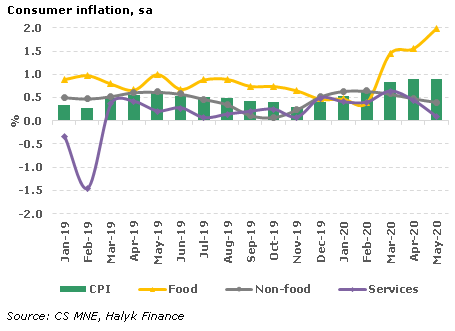According to the Committee on Statistics, inflation in May slowed to 0.5% mom from 0.9% mom in the previous month. In annual terms, the price increase weakened slightly from 6.8% to 6.7%. Given the seasonal adjustment (sa), inflation did not change, amounting to 0.9% mom by our estimates.

According to the results of May, inflation in the food product group amounted to 1.2% mom (+2% mom sa), providing 0.5pp in the total inflation. Fruits and vegetables (+1.5% mom), cereals (+2% mom), oils and fats (+0.9% mom), meat (+1.3% mom). Prices for cabbage decreased (-32.2% mom), rice (-0.2% mom), eggs (-0.2% mom).
Prices for non-food products increased by 0.4% mom (+0.4% mom sa), providing 0.1 pp of contribution to inflation. The cost of antiseptics (+0.8% mom), medicines (+0.7% mom), personal goods (+0.7% mom), household goods (+0.7% mom), automobiles (+0.8% mom). The cost of gasoline and diesel fuel decreased (-0.7% mom).
In the service sector, tariffs fell by 0.3% mom (+0.1% mom sa) with a negative contribution to price increases (-0.1pp). The decrease in tariffs was due to a decline in the cost of housing services (-1.2% mom), the cost of law and education services did not change. Transportation services (+0.3 mom), communication services (+0.2% mom), hairdressing and personal services (+1.4% mom).

Our opinion
Inflation in May showed a sharp deceleration of almost two times to 0.5% mom, although taking into account seasonal adjustment it did not change and amounted to 0.9% mom. Given that many restrictions on economic activity still persisted in May, inflation figures most likely do not fully reflect the changes that have occurred. In the consumer market, food products were mainly sold, the share of their sales in April grew to 52% of the total turnover compared with 33% in normal times. Accordingly, it was food products that set the tone for inflation, where the rate of price growth was measured in double digits in annual terms. In turn, in the segment of non-food products, a slight weakening of price growth apparently occurred under the influence of low demand, oriented primarily to everyday goods. The reduction in tariffs for housing and communal services and the cost of automobile fuel, initiated by the state agencies, which began in April, continued in May. Significant interference by government agencies in pricing in the consumer market can significantly reduce inflationary pressures this year, as a result of which price increases can be significantly lower than the level of 9-11% targeted by the government and the National Bank if the situation with prices on the foreign market does not undergo serious negative changes.








